
Sound, geography, and non-representational theory
by CANDICE P. BOYD and MICHELLE DUFFY
- View Candice Boyd's Biography
Candice Boyd is an artist-geographer and research fellow at the School of Geography, University of Melbourne.
- View Michelle Duffy's Biography
Michelle Duffy is a cultural geographer and Associate Professor in the School of Environmental and Life Sciences, University of Newcastle.
Sound, geography, and non-representational theory
by CANDICE P. BOYD and MICHELLE DUFFY
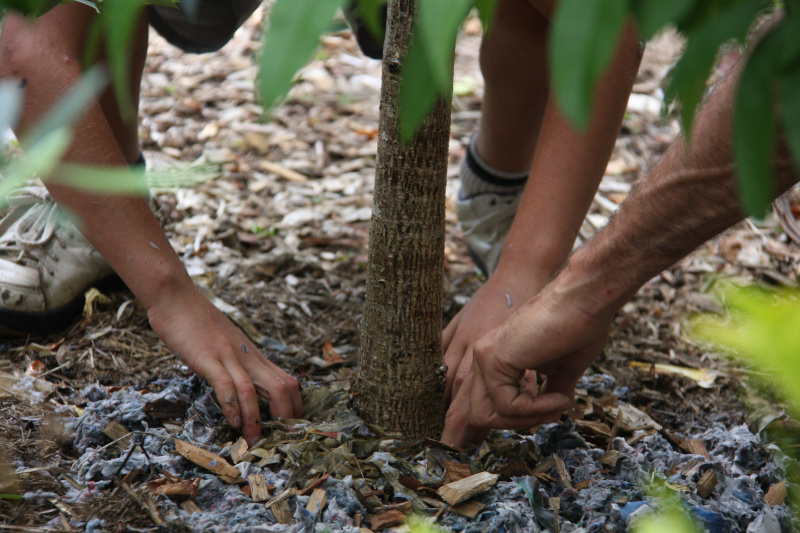
Figure 1: Father and son place wet newspaper mulch around the base of a plant
I: Non-representational theory
Non-representational theory emerged from British Social and Cultural Geography in the 1990s. A book of the same name was published in 2008 by Nigel Thrift, the originator of the theory (Thrift 2008). Taken up enthusiastically by several of Thrift's postgraduate students, non-representational theory was debated and further developed over several years but mostly in a philosophical vein. Then, in 2015, the first text on non-representational methodologies was published (Vannini 2015) demonstrating how non-representational styles of thought and action could be applied to geographical problems and conditions. In 2019, the first book to bring non-representational theory together with the creative arts was published (Boyd and Edwardes 2019), comprising a plethora of examples of how artists and cultural geographers were engaging creatively with the theory in their arts-based research and practice at that time.
So, what is non-representational theory? Anderson and Harrison (2010) argue that non-representational theory is not a single theory but is instead made up of several theories, many of them informed by the 'affective turn' that took place, and continues to take place, across the social sciences and humanities. Put simply, the aim of non-representational theory is to foreground processes that are normally left out of human-centred accounts of the world; things like non-human entities, forces, and affects that while not always part of our conscious awareness nevertheless exert a powerful influence on our actions. Non-representational theory also challenges substance-based understandings of the world in favour of process-oriented ones. Life is always in movement, always unfolding. The world is always a 'becoming-with' -- it is not simply a backdrop for our human activities (McCormack 2017). We are not independent actors in the world but, rather, act in relation with other things that are also in movement and constantly coming in and out of relation with one another. As such, the human is de-centred in non-representational accounts (Boyd 2017a). Finally, and regarding the term itself, non-representational theory argues that there are ways of knowing and 'being' that defy representation because they exist outside of our conscious awareness and outside of human relations (Ash and Simpson 2016).
Affect is a central concept in non-representational theory. While there are many different understandings of the term 'affect' in the literature (see Gregg and Seigworth 2009), affect in non-representational theory is understood as a transpersonal intensity, and is, therefore, spatial. After Massumi (2002) it is also pre-personal and always in excess of the human. Emotion, however, is understood by Massumi (2002) as the intense 'capture and closure' of affect. Thus, affective knowledge held in the body is a 'felt' knowledge, whereas affect itself is always non-subjective and a-signifying. This is the same understanding of affect in Deleuze and Guattari's writings and based on the philosophy of Spinoza (see Deleuze and Guattari 1987). A geography of affect, then, is interested in how affect circulates in and through the social -- that is, how people affect and are affected by this circulation. As Lacey (2016 3) argues, a spatial notion of affect is also central to urban soundscape design because "... it considers the capacity of the urban soundscape to shape the physical and emotional expressions of the collective social body, and importantly, the capacity of the social body to experience what we might term mythic, imaginative and poetic relationships within the affective environments in which they are immersed".
The challenge for researchers informed by non-representational theory is to find ways to 'grasp at' forces that are difficult, if not impossible, to represent. Affective knowledge is only ever an attempt that inevitably fails, but as Dewsbury (2010) argues what is learned in the attempt still counts as knowledge. Heavily influenced by post-phenomenology, Ash and Simpson (2018) describe two styles of working that they call 'allure' and 'resonance'. Allure is a style that emphasises how non-human objects appear in way that appreciates that they are always in excess of what can be sensed by the human body, whereas resonance focuses on those moments when objects and humans collide. Adopted together, allure and resonance enable researchers to be more conscious of the limits of human-environment relations. In a similar vein, Boyd (2017b) describes two styles adopted in her art-geography research, i.e., attunement and fielding. Attunement for Boyd (2017b) was not object-focussed but rather directed towards fieldwork 'spacings', or the relations between the body and other bodies and things. Fielding, akin to Manning's (2013) description of autistic perception, involves a flattening of perception to take in the whole of the sensible field, as it is encountered in fieldwork. Fielding, as a style of perceiving the world, is also relevant to soundscape design and sonic ecologies.
II: Sonic geographies
Growing interest in non- and more-than-representational aspects of social and spatial practices offer exciting conceptual approaches for exploring how everyday life unfolds across time and space. Underpinning Thrift's proposal that non-representational theory considers 'the geography of what happens' (2008 2, emphasis in original) is the challenge this framework offers in terms of identifying and seeking to understand the relationships that constitute life--'that this is about movement, modes of perception (thought, pre-cognition, pre-individual), emergence, intensities and encounters' (Doughty, Duffy, and Harada 2019 2). This is particularly pertinent when we consider sound, because it is not something that can be perceived in an instant; rather we are asked to enter into the temporal and spatial unfolding of the sonic event. Moreover, we make sense of what we hear by attempting to bring into some sort of assemblage the sonic impacts on our bodies, whether that be through our ears or in the ways that sound vibrations hit and resonate on and in our bodies (Duffy 2016).
An engagement with sound-specific approaches can assist in rethinking our everyday relationships, that 'by subverting our culturally entrenched reliance on seeing as a way of distancing and differentiating the self from others; we were perhaps more open to entering a relationship with the environment not as detached observers but as engaged participants' (Mohr 2007 108). This has implications for our approach to data collection and (re)presentation, for, as Wood, Duffy, and Smith (2007) suggest, in order for a clearer understanding of the significance of sound in our lives, we need to work with a conceptualisation 'that emphasises [sound's] being and doing -- its non-representational, creative, and evanescent qualities' (868). This means, too, that we need to consider how we might work with the 'not-quite-graspable' (Vannini 2015 6) characteristics of sound.
Chow and Steintrager (2011 2) conceive of sound as 'points of diffusion that in listening we attempt to gather'. They argue that this 'work of gathering', of trying to give coherence to what is heard, 'implies that subjectivity is involved whenever we try to draw some boundary in the sonic domain' (Chow and Steintrager 2011 2). Yet, our body does more than simply capture sound. How we process sound's raw physical elements influences our interpretation of sonic events. Listening is a material, physical and bodily process, a form of corporeal thinking that is 'immersed in the substance and the historical as well as sensational, fictional, and obsessive layers coating and entwining any sonic experience -- sensory critique in action (Schulze 2018 156). What emerges is an auditory self that is informed by the idiosyncratic nature of us as individual listeners -- our corporeality, historic experiences, the situatedness of our actual listening, as well as the material and technical character of our listening spaces. Even so, this auditory self is not simply 'a boundary point that impedes or stops the flow of music and sound' but is also a 'potentially initiatory in relation to sound and music -- as much agentive and mediating as mediated' (Born 2013 3-4). Making sense of sound events, then, is more than a gathering of points of diffusion whereas making sense, as suggested by Deleuze and Guattari (1987), is constituted through an assemblage, involving a "constellation" of elements that converge at certain spatial and temporal moments.
Yet, we also need to be wary of an approach that suggests we can fully know the sound world. Scholars have used a range of methodological approaches in the analysis of the sonic aspects of our world, including Schafer's (1969, 1977) original use of soundscape studies as a means to determine how environmental sounds impact on our psychological and socio-cultural wellbeing (Davies et al. 2013, Dubois Guastavino and Raimbault 2006, Truax 2001), while Lefebvre's (2004) rhythmanalysis examines how the rhythmic qualities of social, cultural and political spheres of everyday life interpellate us within space in specific ways (Boyd and Duffy 2012, Edensor 2010, Simpson 2008). Yet, even as we are immersed in sound, many of the sounds in which we are interpellated may not be registered consciously. Nonetheless, these sounds may have powerful non-conscious affects, and, therefore, cannot be dismissed as meaningless noise (Duffy Waitt and Harada 2016). Sonic processes and practices have the power to affect, and this is something initially sensed, not necessarily known (Moisal, Leppänen Tiainen and Väätäinen 2017). Listening, therefore, is not a passive thing; 'the most distinguishing feature of auditory experience [is] its capacity to disintegrate and reconfigure space' (Connor 1997 206). In our explorations of the sonic world we seek to capture experience, feeling, emotion and affect in order to reveal how sound has 'the potential to reconfigure listeners' relationships to place, to open up new modes of attention and movement, and in so doing to rework places' (Gallagher 2015 468).
III: Sound-centred geographical fieldwork
In this section, we describe in brief what has been published in full as a short monograph (see Boyd, 2017b). From 2010-2015, Boyd (first author) undertook a joint PhD in geography and the creative arts at the University of Melbourne, Australia. In what would become a practice-based PhD, she was inspired by non-representational theory to study the materialities and immaterialities of therapeutic art making, with a wider aim to reclaim therapeutics as ecological and spatial. Starting with her own visual arts practice, she gradually engaged with other artists to explore practices that were different to her own; these were slow art, dance movement therapy, poetic permaculture, subterranean graffiti, and improvised performance.
As apparent from the previous sections of this essay, non-representational theory necessitates an approach to research that emphasises joint action, i.e., the relational-affective qualities of things in movement (Thrift 2008). Therefore, in order to study the non-representational geographies of therapeutic art making Boyd decided to take part in these other practices directly. This meant engaging with a performative research paradigm, rather than a qualitative one (Haseman 2010). Performative research deals with symbolic data gleaned from processes of making and doing; in Boyd's case, these were video, photos, and audio recordings collected in the 'field'. Furthermore, the knowledge gains from performative research are held, at least in part, within the thing that is made (or performed). Therefore, for practice-based forms of knowledge to be translated they must be audienced -- seen, heard, or witnessed (if only they could also be smelt and tasted!)
Researching ambiances also necessitates an immersive approach. As Thibaud (2019 176) suggests,
[w]e may start by positioning ourselves on a medial plane and approach ambiance as a bridge, an in-between. By focusing our attention on sensory flows we may highlight its immersive capacity. We may then move to a vital plane and query ambiance ... Lastly we may consider a social plane and explore ambiance as a background ... By proceeding in this way our purpose is to probe ambiance, starting from its intensive forces and moments of establishment. Opening the way for ambiance's powers of impregnation, these three paths share the same basic argument: experiencing ambiance entails an imperceptible transformation in us, but through such contact we too change it. In other words ambiance exerts unobtrusive forms of influence and at the same time it is affected by the existences it accompanies.
As such, ambiances cannot be observed. One must participate in them and allow oneself to affect and be affected by them. Because of this, audio recording became a preferred method over the course of the project as Boyd started to photograph less and less. She simply set the audio recorder to run for up to 2 hours at a time, while she became fully immersed in the practices that she was researching.
Back in the studio, Boyd worked with 'sense data' collected in the field to produce a series of digital works, some visual and some sonic. For the sound works, of which there were three, her aim was to create a mimetic sense of space that would give the listener a semblance, not a facsimile, of fieldwork events she had experienced by taking part ( see Massumi 2011 for more on semblance). This involved 'curating' and arranging the sounds to emphasise particular moments or experiences, juxtaposing sounds, layering sounds, and creating crossfades and transitions between sounds to create a sense of flow or 'drift' from one moment to the next. These choices were less aesthetic than they were affective, influenced by the capacity of memory to create these transpositions (Braidotti, 2006). The process was only partially intentional, however, as Boyd also wanted the sounds themselves to 'speak' by accidently falling into arrangement, rather than fully orchestrating them. The soundscape that emerged from these processes in relation to poetic permaculture can be heard here:
The urban garden where these sounds were recorded was designed by an artist-activist collective called 'Artist as Family' on commission from the Museum of Contemporary Art in Sydney, Australia. Artist as Family were visiting the garden to undertake maintenance on the food forest they had created together with and for the local community. Boyd had been invited to join them as a researcher. Other people came and went over the course of the day, but overall it was a small gathering with most of the work being carried out by the artist themselves.
The composition of the soundscape was purposeful in that Boyd wanted to highlight certain things about the practice of permaculture that make it therapeutic in this setting. There was one particular activity that highlighted this the most to her and that was the making of mulch out of newspaper in a bucket of water (although there are many others such as digging, raking, and the sharpening of old-fashioned gardening tools). At times, there were many hands in the bucket as people 'squelched' through ripped up newspaper before gently laying it around the base of a plant. There was a certain rhythm to this practice that centred on the bucket as a fixed object, which was also a meeting place for verbal exchange. The gentleness of these exchanges as 'family' are also evident as you hear the voice of a parent or a child as they speak to one another. But what also made this practice therapeutic is the juxtaposition of these gentle exchanges with the aggressiveness of the traffic noise. This garden is on the grounds of a church in Surry Hills in Sydney and at one of its busiest intersections, so that as we listen to the practices of tending and caring we hear these as they are enveloped by sounds that potently symbolise the earth's 'destruction'. In this way the activism of 'Artist as Family' is also evident as an ethico-politcal intervention within the urban landscape as they perform acts of nurture and repair.
IV: The work of gathering: Mapping the non-representational
Listening is fundamental to being able to move towards a 'making sense' of sonic processes and practices embedded within a soundscape. The approach to 'making sense' employed in this instance draws on visceral sonic mapping developed by Duffy, Waitt and Harada (2016). Underpinning this methodology is an understanding that the listening body is continually in process, constituted in and through place, and that these processes operate through the visceral. Such a practice of listening reminds us that we are engaged in 'a whole web of relationships ... anchored as much on those who listen as on those who make the sound' (Smith 2000 633). Listening to sound is to engage in what Smith (2000) calls 'the doing' of sound, rather than undergoing a study of an assumed fixed, bounded and visualised object. A focus on the viscerality of listening 'draws attention to the embodied ways - moods, emotions and bodily sensations - that a person inhabits the world' (Duffy et al. 2016 52).
This type of analysis begins by repeated listening to the soundscape in order to establish and map the sounds heard, a time-consuming method that enables the listener to notate the different sound elements (such as timbre, rhythm, silence) as they unfold within the soundscape. Then a re-listening to the soundscape is undertaken, noting the relations between different sound elements. Mapping these sound elements may initially mean simply indicating when different sound elements coincide, as well as where they are positioned in terms of foreground, middle ground and background. This is then followed by a more critical form of listening to determine the possible relations between the sonic elements of the soundscape. Figures 2-6 at the end of this article present the outcome of this method in the form of a sonic map generated by Duffy (second author).
The map produced by Duffy of Boyd's Food Forest Soundscape led to the uncovering of a set of five phrases within the overall soundscape composition, each with differing sonic components and interactions that constituted a different focus towards the practices of urban permaculture. Boyd's compositional choices in arranging particular sound elements capture her body's responses to being in this place while participating in different activities with the human and non-human actors of the urban garden. Even so, these sonic elements are brought together in ways that make the soundscape coherent, such as the constant hum of traffic throughout the piece, while the sounds of water offer a counterpoint to what we listen to, interjecting in response to (human) activities as the soundscape unfolds.
This 'work of gathering' sonic elements resembles a process of mapping rather than a tracing of sound; each time the listener enters the soundscape, they bring into its unfolding different and other emotional, affective, sensual, cognitive and embodied elements that go onto constituting that specific soundscape. We suggest that this process is important because, as Deleuze and Guattari (1987 12-13) argue, mapping 'has multiple entryways, as opposed to tracing, which always comes back "to the same". In this way, the visceral sonic map that is created out of such a critical listening corresponds to the 'openness of performance ... [an attempt] to capture the multiple ways of the unfolding of time-space' (Duffy et al. 2016 52).
V: In closing
In this essay we have introduced some of the concepts from non-representational theory that help us envision a wider geography of sound, both in the production of an urban soundscape and through the mapping of that soundscape. While we have valorised our approaches through our writing, we are also aware of recent critiques of sonic methods within our discipline. As McFarlane (2020 298) argues, soundscape in particular has come under scrutiny for the '... ecological and ideological assumptions about "which sounds matter" and which sounds should be ignored or muted altogether' -- this, in turn, raises political questions about 'whose ears matter' and 'whose sounds matter'. So, while we affirm sonic methods in geography, we also consider them with caution. Namely, that no one should not be lulled into thinking that soundscape is a representation of reality. It is, however, a useful tool for thinking and communicating the non-representational, which we have endeavoured to demonstrate here.
Finally, and with respect to the theme of this special issue, our joint work might be considered as a double translation -- the first movement being Boyd's creative work which aimed to translate the ambiances not only of the urban environment but the affective qualities of the practice of permaculture itself into a sonic form that could be re-audienced, and the second movement as Duffy's sonic mapping which was a translation of the soundscape. The sonic mapping, as an exercise in listening and as a visual output, emphasises a particular form of spatial listening that extends beyond the human whereas the soundscape demonstrates how the collection and selection of sounds in soundscape design can be sensitive to wider ethical and political concerns. Taken together, both approaches have broader relevance for urban soundscape design in that they promote styles of 'being-with' and 'listening-with' that are attuned to the multiplicities of space-times.
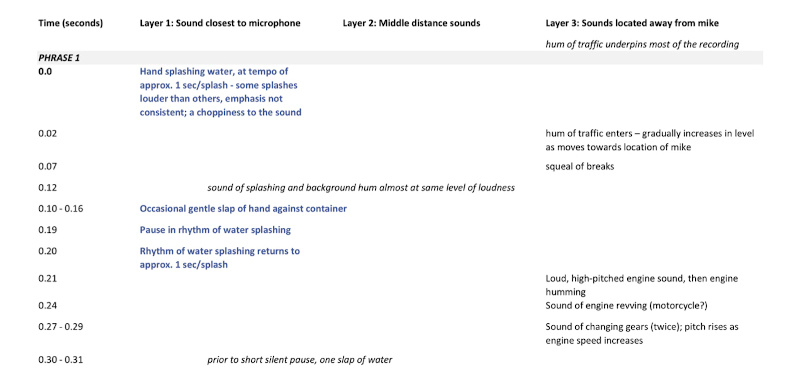
Figure 2: Phrase 1

Figure 3: Phrase 2
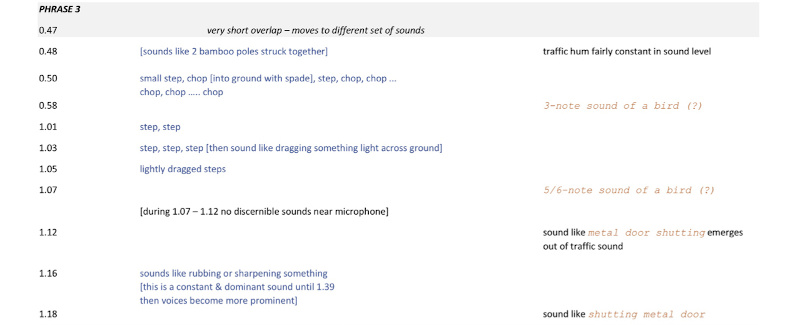
Figure 4: Phrase 3
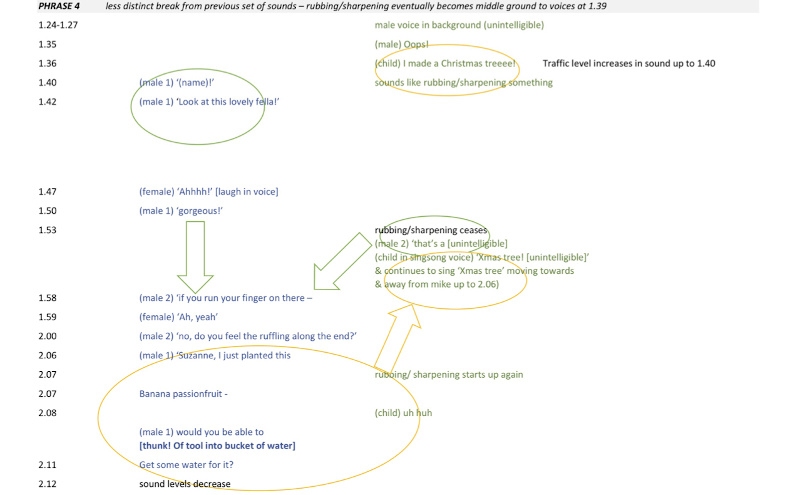
Figure 5: Phrase 4
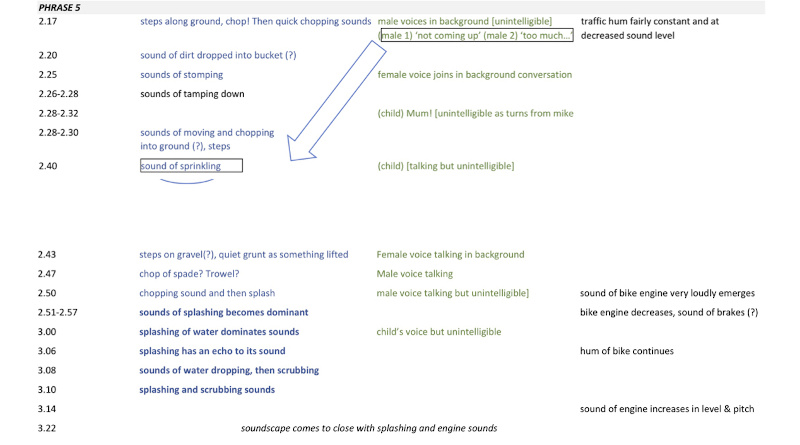
Figure 6: Phrase 5
Works cited
Anderson, Ben and Harrison, Paul. Taking place: Non-representational theory and geography. London: Ashgate, 2010.
Ash, James and Simpson, Paul. "Postphenomenology and method: Styles for thinking the (non)human". GeoHumanities, 2018. DOI: 10.1080/2373566X.2018.1543553.
Born, Georgina. "Introduction". In G. Born (Ed.), Music, sound and space: Transformations of public and private experience. Cambridge: Cambridge University Press, 2013.
Boyd, Candice P. "Poetry and the non-representational". ACME: An International Journal of Critical Geographies, vol. 16, 2017a, 210-223.
Boyd, Candice P. Non-representational geographies: Thinking through practice. London: Palgrave Macmillan, 2017b.
Boyd, Candice P. and Edwardes, Christian. Non-representational theory and the creative arts. Singapore: Palgrave Macmillan, 2019.
Braidotti, Rosi. Transpositions: On nomadic ethics. Cambridge, MA: Polity Press, 2016.
Chow, Rey and Steintrager, James. "In pursuit of the object of sound: An introduction". Differences: A Journal of Feminist Cultural Studies, vol., 22, 2011, 1-9.
Connor, Steven. "The modern auditory I". In R. Porter (Ed.), Rewriting the self: Histories from the Renaissance to the Present. London: Routledge, 1997.
Deleuze, Gilles and Guattari, Félix. A Thousand Plateaus: Capitalism and Schizophrenia, [trans. B. Massumi]. Minneapolis: University of Minnesota Press, 1987.
Dewsbury, John-David. "Performative, non-representational, and affect-based research: Seven injunctions". In D. DeLyser, S. Herbert, S. Aitken, M. Crang, and L. McDowell (Eds.), The SAGE Handbook of Qualitative Geography. London: SAGE, 2010.
Doughty, Karolina, Duffy, Michelle and Harada, Theresa. "Sounding places: An introduction". In K. Doughty, M. Duffy, T Harada (Eds.), Sounding Places: More-than-representational geographies of sound and music. Cheltenham, UK: Edward Elgar, 2019.
Duffy, Michelle. "Re-sounding place and mapping the affects of sound". In T. Leppänen, P., Moisala, M. Tiainen and H. Väätäinen (Eds.), Musical Encounters with Deleuze and Guattari. New York and London: Bloomsbury, 2016.
Duffy, Michelle, Waitt, Gordon and Harada, Theresa. "Making sense of sound: Visceral sonic mapping as a research tool". Emotion, Space and Society, Vol. 20, 2016, 49-57.
Gallagher, Michael. "Sounding ruins: reflections on the production of an 'audio drift'". cultural geographies, vol. 22, 2015, 467-485.
Gregg, Melissa and Seigworth, Greg J. The affect theory reader. Durham: Duke University Press, 2019.
Haseman, Brad. "Rupture and recognition: Identifying the performative research paradigm". In B. Bolt and E. Barrett (Eds.), Practice as research: Approaches to creative arts enquiry. London: I.B. Tauris, 2010.
Lacey, Jordan. Sonic rupture: A practice-led approach to urban soundscape design. London: Bloomsbury, 2016.
Manning, Erin. Always more than one: Individuation's dance. Durham: Duke University Press, 2013.
Massumi, Brian. Semblance and event: Activist philosophy and the occurrent arts. Minneapolis: MIT Press, 2010.
McCormack, Derek. "The circumstances of post-phenomenological life worlds". Transactions of the Institute of British Geographers, no. 42, 2017, 2-13.
McFarlane, Key. "Negative research: Sonic methods in geography and their limits". The Professional Geographer, vol. 72, 2020, 297-308
Mohr, Hope. "Listening and moving in the urban environment". Women and Performance: A Journal of Feminist Theory, vol. 17, 2007, 185-203
Moisala, Pirrkko, Leppänen, Taru, Tiainen, Milla and Väätäinen, Hanna. Musical Encounters with Deleuze and Guattari. New York and London: Bloomsbury, 2017.
Schulze, Holger. The sonic persona: An anthropology of sound. New York: Bloomsbury, 2018.
Smith, Susan J. "Performing the (sound)world". Environment and planning D: Society and Space, vol. 18, 2000, 615--637.
Thibaud, Jean-Paul. "The lesser existence of ambiance". In T. Griffero and M. Tedeschini (Eds.), Atmosphere and Aesthetics: A Plural Perspective. Cham: Palgrave Macmillan, 2017.
Thrift, Nigel. Non-representational theory: Space, politics, affect. New York: Routledge, 2008.
Vannini, Phillip. Non-representational methodologies: Re-envisioning research. New York: Routledge, 2015.
Wood, Nicola, Duffy, Michelle and Smith, Susan J. "The Art of Doing (Geographies of) Music". Environment and Planning D: Society and Space, vol. 25, 2007, 867-889.

